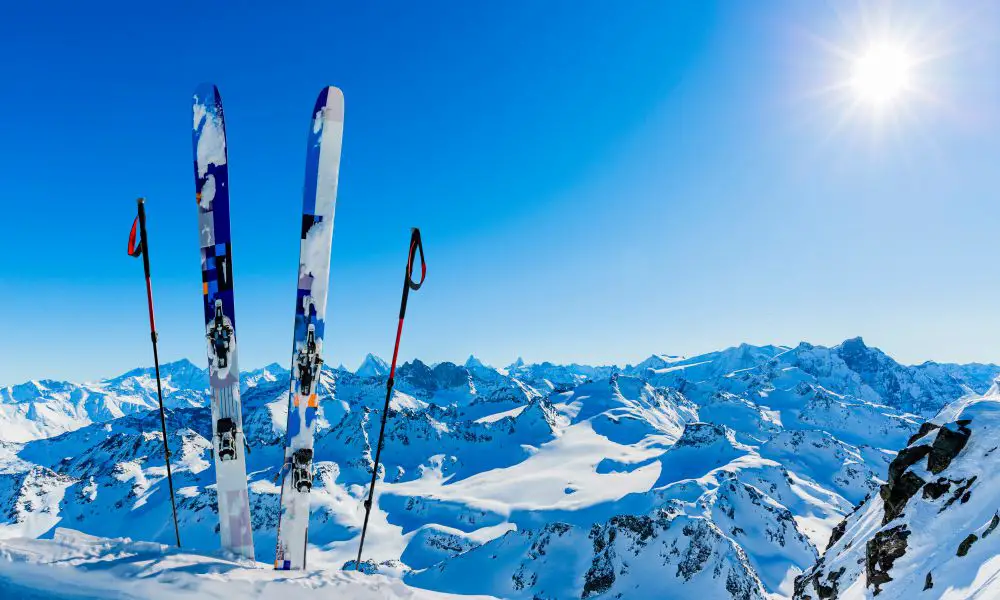Not learning how to stop skiing can make your world turn around. And by saying that, literally make your turn around while your head buzzes.
Stopping is the most important trick for you to learn when skiing. Without learning how to stop, you’ll crash against trees, people, and other obstacles in the ski resort.
Not to mention that you can’t perform fancy-looking tricks too. Some maneuvers in skiing require you to master the arm of stopping for their execution.
This is why ski instructors teach students how to stop before how to start moving forward. Making the ski move is easy. You have the slope and the poles to do the work for you. However, stopping – not that easy.
Stay here and read this article that serves as a quick crash course that will teach you how to stop when skiing for beginners. But before that, let’s answer the question.
How To Stop On Skis
Why Learning How To Stop Is Essential For Beginners?
Recreational skiers zoom on their skis at 10 – 20 mph, downhill daredevils; 40 – 60 mph, Olympians; 70 – 95 mph, and professional athletes; 150 mph. As you see, the slowest average speed of a skier equals the slowest average speed of a moped, which is already enough to deal you with grave injuries if an accident happens
Okay, it’s already obvious that you need to learn how to stop so that you won’t get into accidents. But still, allow me to give you a quick explanation so that you stop seeing the art of stopping as nothing but a basic maneuver in skiing.
Crashing into a tree with a loud thud isn’t that terrifying. Injuries aren’t that serious, really. You only have to suffer from a bleeding nose, a buzzing head, dislocated or fractured bones, or sore muscles. Again, not that serious.
You will also look cool at the ski resort if you ski without knowing how to stop. Cool enough to run over other skiers or bump on them. That being said, cooly annoying.
If you don’t get what I mean, then let me rephrase the previous statements. Stopping is essential because it prevents you from injuring yourself and others as well.
Is Using The Skiing Pole The Most Basic Method To Stop When Skiing?
Seasoned skiers advise you not to use the skiing pole. The skiing pole is for moving and not for stopping. It’s designed to push you forward and not to cancel kinetic force.
So the skiing pole isn’t the most basic method of stopping when skiing.
However, this doesn’t mean that you can’t use it to decelerate; sometimes, using the skiing pole is acceptable if the beginner is only starting to get the hang of decelerating while skiing.
Leg and body coordination is essential when stopping. Most beginners don’t have this yet. This is when the skiing pole becomes useful.
If you’re moving slowly (say 2 mph or 5 mph), it’s not bad to stop using the skiing pole. It can help you make immediate stops just in case something is in the way.
But do you use the fishing pole to decelerate? It’s very basic. All you need to do is thrust the fishing pole on the snow in front of you.
However, understand that it’s only acceptable to use the skiing pole on your first 2 – 3 days at the ski resort. As soon as your feet are comfortable on the skis, ditch using the poles for stopping and use basic stopping methods in skiing ASAP (more about this later on).
So what happens if you use the skiing pole to stop when you’re moving fast downhill? Don’t even think about doing it. Using it can make you lose balance, stumble and roll hard downhill, or dislocate your arms or shoulders.
What’s The Basic Method To Stop When Skiing?
The snowplow method is the basic method to stop when seeing. It’s so easy that if you can’t learn it quickly, be ashamed because 10-year-olds sometimes get the hang of this technique without anyone teaching them.
To perfectly execute the snowplow, always remember to put the skis in a triangular position – front tips close and end tips apart.
You don’t have to move the ski forward to practice this for the first time. A nice flat terrain is where I recommend you to learn the snowplow.
To start, position your legs together at least half a meter apart. After this, start bringing the front tips of the skis together. Be sure, involve your knees and shins to make this easier. Stop once the front tips of the ski area 10 – 15 cm apart.
Keep repeating the above process until you can execute it without thinking about it.
Once you can perform the snowplow automatically while being stationary, incorporate a jump in your practice. All that you have to do is perform a mini jump while being in a neutral position, then execute a snowplow upon landing. When you mastered this, proceed to the final step of learning how to snowplow.
Go to an easy slope to start learning how to snowplow while moving. Practicing the snowplow while moving is a piece of cake. While moving, slowly bring the tips together. Remember to keep your balance by doing this. By the way, bend your knees a little to maintain balance.
As soon as the front tips are close to each other, the speed of your movement will start to decrease until you come to a halt.
How Effective Is The Snow Plow Method?
The snowplow effectively puts you to stop when skiing at slow to moderate speeds. This method decelerates your movement without requiring you to shift your body in any direction. With that said, the snowplow is the most relaxed way to stop when skiing.
However, you can’t use the snowplow if you’re skiing at fast speeds. Moving fast makes it hard to bring the tips of the ski together. Also, it can cause you to fall flat on the surface of the snow face first.
What’s The Most Uncomfortable Way To Stop When Skiing?
Using natural or artificial obstacles on the ski resort to stop is the most uncomfortable method to stop when skiing. Examples of obstacles that you may effectively use are snow mounds, exposed roots of trees, low lying branches of trees, ski runway crash guards, etc.
Utilizing these obstacles can put you to a stop no matter how fast you’re going. However, the consequence can be devastating. Snow mounds can make your trip and fall flat on the snow. Exposed roots of trees can injure your feet. Low lying branches can cut your fingers or slap your face. And crash guards can hurt your body big time.
Parallel Stop: A More Advanced Method of Snowplow
I forgot to mention that learning the snowplow opens the gates of learning effective turns. Its continuous utilization makes both of your feet flexible, thereby making it easier for you to turn your feet inside out or outside.
Snowplow plus directional control leads to the parallel stop – a method of stopping in skiing where you go right or left then proceed to perform a quick snowplow.
The parallel stop is an improved version of the snowplow. Unlike the snowplow, the delay of stopping is much shorter with a parallel stop. That’s why this method is best utilized if you’re skiing at speeds ranging from 20 mph – 30 mph.
Another way to perform a parallel stop is to lean on the side of the ski so that it digs on the now. Note that the leaning should be done in the direction that counters where the slope is going. Remember this because it counters the forward motion that the steepness of the slope brings.
Performing a parallel stop this way requires shifting body weight since you have to lean. As a newbie, certainly, you might not know the importance of this in skiing. Allow me to explain it to you quickly.
Bodyweight and Stopping
Your body weight can slightly offset your center of gravity on the ski. With the perfect balance on the ski, you can use this to your advantage for :
- making sharp turns
- digging on the snow with the ski
- and performing flips and twists
Let’s leave the other two for the meantime and talk about digging on the snow only since the subject matter is all about how to stop when skiing for beginners. Digging on the snow with the feet only is possible. However, doing so will be hard. That’s why to make it easier to have to use your body weight.
But how does bodyweight? Leaning right or left applies pressure on the tips of the ski. Now, this pressure makes the ski dig on the snow without the feet making any effort. And when the ski digs on the snow, friction is produced, which in turn leads to a more effective deceleration.
How To Stop In A Flash While Skiing?
What if obstacles suddenly appear out of nowhere while you’re skiing? At such a moment, what you need is to get yourself to stop abruptly without any delays. The previous stops that I taught you to fail to accomplish this. That’s why you have to have the hockey stop as a part of your skiing skillset.
The hockey stop is an instant top in skiing where you turn the tips of your skis 90 degrees. This type of stop has little to no delays. It’s perfect for preventing collisions against people or trees, and deceleration for performing high-speed turns.
Mastering the hockey stop is a bit difficult. However, you’ll learn within weeks of continuous practice.
So how is a hockey stop performed? A hockey stop is performed by suddenly positioning perpendicular on the snow with your body weight going backward. What this does is dig the ski on the surface leading to the production of strong friction.
Bending your knees, putting your weight on the ski, adjusting the direction of your body weight’s fall, and keeping your legs firm are the secrets to executing a perfect hockey stop.
The hockey stop is an ideal method of stopping while skiing if you’re heavy. Having a sheer amount of weight makes it easier for you to make the skis dig on the snow.
By the way, you don’t use the hockey stop if there are lots of people around. Since this technique makes the skis dig on the snow, a lot of snow debris gets sprayed all over while doing it. This snow debris might fall on anyone and can hurt them.
You Can Also Use The Slope To Stop
The forward motion of the skis is produced by the downward terrain of the slope. That’s why if you turn and make the skis against it, you can also put yourself to a halt.
This method is actually very easy. All that you have to do is execute any turning maneuver that you already know. The only important thing to remember is to turn in a way that makes the skis face the upper sections of the slopes. This works because it cancels the kinetic force that comes from the slope’s downward terrain.
But this technique might not put you to a halt in all situations. Sometimes, if the snow is too slippery, you might ski backward after doing this technique. If this situation happens, you can use the poles to cancel any remaining forward movement.
Hugging The Snow Is The Last Resort
You can also choose to make yourself fall on the snow as a last resort. Of course, doing this means that you have to smash your face and body on the slope itself. However, the pain that you feel after doing this is better than injuring yourself after falling from a low cliff, smashing on a tree, and encountering any other obstacles in the ski resort.

